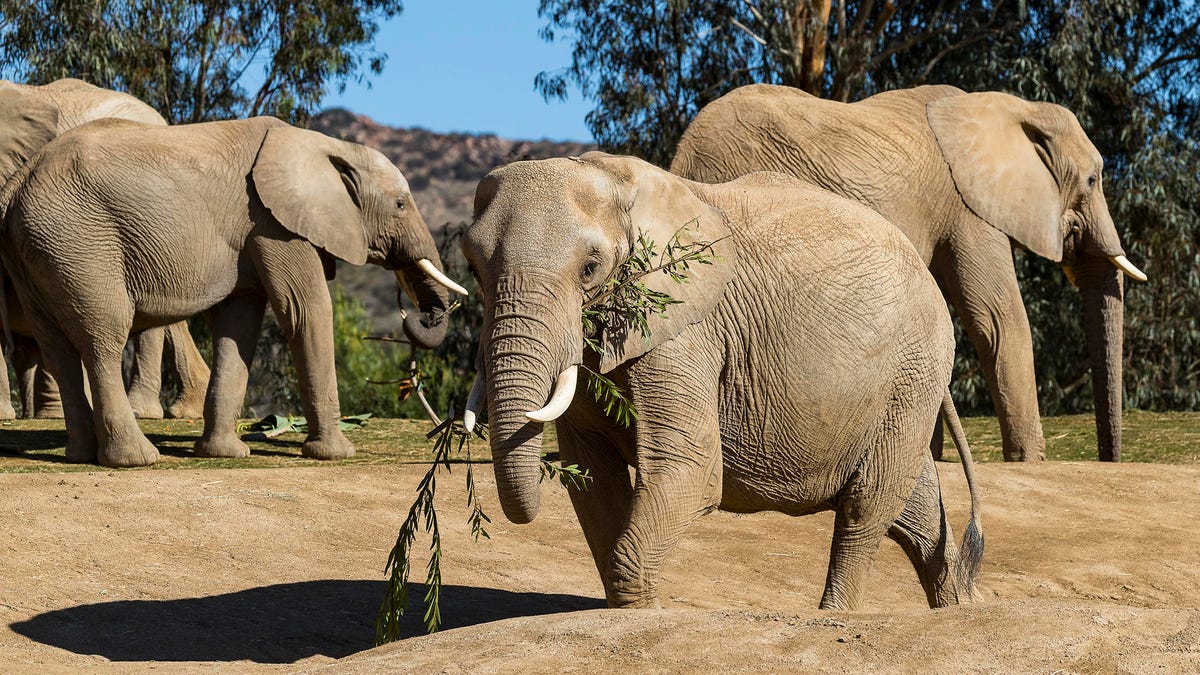Ancient mammoth DNA could help save threatened elephants
Could elephant-mammoth hybrids roam the tundra? Researchers analyze the genes of several elephant species, and find genes from their extinct ancestors could help save them.

Swazi, the female elephant in the center, provided a reference genome for the study.
An international team of scientists on Monday published the most detailed look yet at the genetic makeup of several different species of elephants, including extinct giants like mammoths and mastodons.
The study tells a complicated story of a resilient family of animals now at risk and how using the genes of their ancestors to save them might be easier than previously thought.
The paper, published in the Proceedings of the National Academy of Sciences, describes elephants' evolutionary picture as complex and full of widespread interbreeding.
"Interbreeding may help explain why mammoths were so successful over such diverse environments and for such a long time," evolutionary geneticist Hendrik Poinar, one of the paper's senior authors, said in a news release.
But that behavior has all but stopped among the few species that remain on the planet today.
"There's been a simmering debate in the conservation communities about whether African savannah and forest elephants are two different species," explained David Reich, another senior author, from MIT's Broad Institute and the Department of Genetics at Harvard Medical School. "Our data show that these two species have been isolated for long periods of time making each worthy of independent conservation status."
The new research could also boost elephants' chances of survival over the long term through more high-tech and unorthodox means: by showing that it may be relatively easy to genetically engineer a mammoth/elephant hybrid that can survive in different climates and is less attractive to poachers.
"This paper would argue that because of the act of hybridization between the species in the past, there probably won't be as many limitations to that from an actual physiological/biochemical (perspective)," Poinar said. He is also director of Canada's McMaster Ancient DNA Center.
To be clear, Poinar isn't talking about bringing back whole woolly mammoths from oblivion, as one effort to create a mammoth clone seems to be pursuing. Rather, he's interested in what some call "de-extinction" conservation, which involves introducing genetic traits from extinct species into the genomes of extant ones. It's like giving them a blast from the past genetically so that they might also get a boost in the here and now.
"What we see critically is that both Asian and African elephants are at abysmally low -- both genetic diversity wise and just numbers -- in the wild. If (de-extinction) efforts are really to try and save this phenomenal family, those efforts should be entirely focused on saving the contemporary populations of elephants. Those are the ones that need us."
Leading the de-extinction charge in many ways is George Church, also of Harvard and the Broad Institute, but not an author on the new research. He says the genomes of both extinct and living elephant species are an important resource. Church, in an email to me, laid out the benefits of using them to create mammoth/elephant hybrids.
"We have been focusing on increasing diversity and viability of contemporary Asian elephants via 1. Ancient genes; 2. Small or no tusks to reduce poaching; 3. Resistance to EEHV (Elephant endotheliotropic herpesviruses) which is a extinction-level threat. 4. Expansion of their homelands to include colder yet vast territory."
We are likely still a ways off from furrier, short-tusked and disease-resistant versions of today's elephants roaming the tundra of Siberia, Canada or Alaska, though.
Up next, the researchers hope to continue their investigations into how the introduction of new genetic materials from other elephant lineages allowed different species to adapt to new habitats and changing climates in the past, and how it could again in the near future.
Crowd Control: A crowdsourced science fiction novel written by CNET readers.
Solving for XX: The tech industry seeks to overcome outdated ideas about "women in tech."

